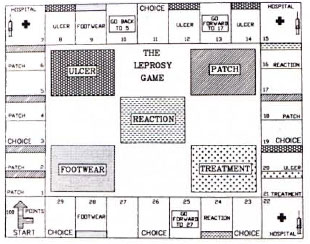- Volume 60 , Number 1
- Page: 91–2
The leprosy game; a health education tool
To the Editor:
Interaction, incentive, disincentive, and repetition are four factors the interplay of which influences the outcome of a learning experience in experimental as well as real life situations. All games have a scoring system which acts both as an incentive and a disincentive to the players. Repetitive playing sessions reinforce the rules and tricks that one needs to use in a winning strategy. Health education is an important factor in the control of leprosy (2). Cognizance must therefore be taken of the above principles of learning during the design and delivery of health education (1).
I have designed an indoor game suitable for health education purposes in leprosy (The Figure). The principles used can be manipulated to modify the game to suit other educational purposes as well; the training of paramedical workers springs to mind immediately and, with intricate details, the teaching of medical students. The game attempts to make health education an enjoyable process.

The figure. Game board for "The Leprosy Game."
The crucial areas of health education in leprosy are: 1) ulcers, 2) patches, 3) appropriate footwear, 4) reactions, and 5) treatment. The game's simple questions have been formulated for each of these areas and may be answered with either "Yes" or "No." Twenty or more such questions are printed one on each card which measures typically 4 x 5 cm. Answers, incentives, and disincentives are printed on the same card. An incentive for the correct answer could be "Move forward five spaces" or "Collect 25 points." A disincentive for the wrong answer could be "Miss a turn" or "Pay a penalty of 20 points," or "Go directly to hospital."
One of the players is appointed "Doctor" and reads the contents of the cards and asks the questions of the other players. Guessing is allowed since this would serve to reinforce the correct answers.
To start, the players have to throw a "six" on a single, six-sided die. Players must progress along the numbered segments of the board corresponding to the throw of the die. They must answer the questions pertaining to the segments which are so marked. Some questions pertaining to "Patch" may read: 1) A leprosy patch can appear anywhere on the skin of the body. 2) A leprosy patch often shows a loss of sweating. 3) A leprosy patch is caused by God's curse. 4) All patches on the skin are due to leprosy.
Players must throw a "six" and pay a penalty to get out of the hospital since it is not desirable for patients to go to the hospital in the first place. The space labeled "Choice" enables the players to choose whichever topic they feel is their strong point. They may choose the topic which they know has more incentives per card, also.
A points system consisting of various colored cards, representing various values, is incorporated into the game in order to authenticate the incentive/disincentive scheme of things. The person with the maximum number of points after a fixed time is declared the "Winner."
- Jayanth K. Devasundaram, M.B.B.S.
Leprosy Control Unit
Richardson Leprosy Hospital
Miraj, Maharastra 416410, India
Acknowledgment. The Superintendent, Dr. P. D. Samson, and other staff members of the Leprosy Control Unit, Training Unit, Records and Nursing Sections of the Richardson Leprosy Hospital are thanked for the cooperation and encouragement given during the development of this game.
REFERENCES
1. FRIEDERICKS, R. C. A multimedia approach to health education. Lepr. Rev. 62(1991)329-332.
2. MCDOUGALL, A. C. and GEORGIEV, G. D. Educational material for the patient with leprosy. Lepr. Rev. 60(1989)221-228.